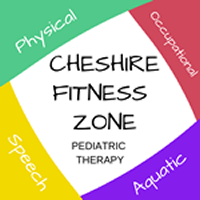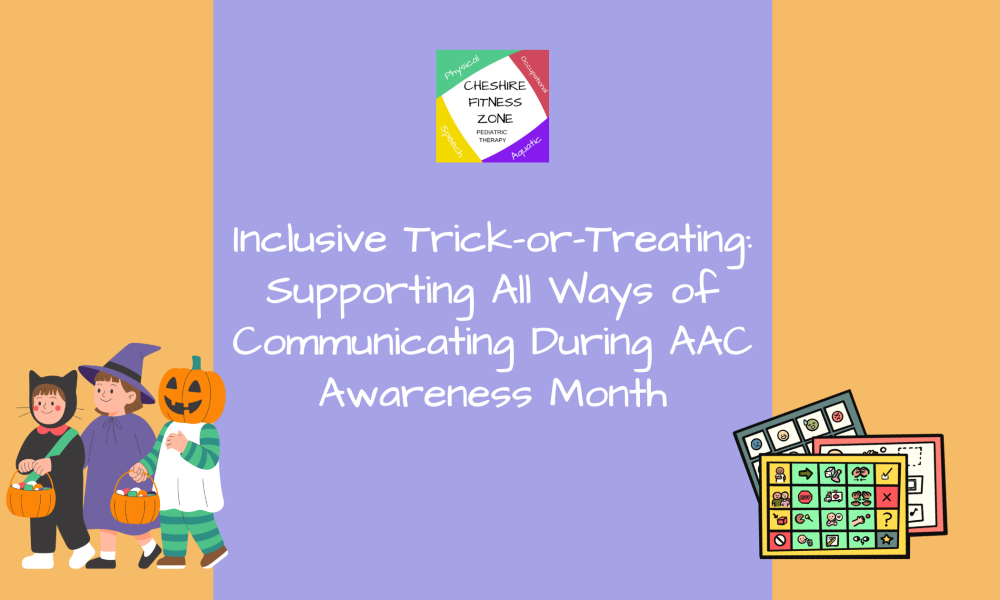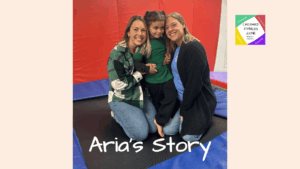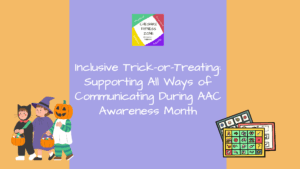Inclusive Trick-or-Treating: Supporting All Ways of Communicating During AAC Awareness Month
Happy Halloween! We are wishing you a fun and safe holiday and wanted to share simple ways to include children of all abilities in trick-or-treating!
October is also AAC Awareness Month, a time to highlight and support the many different ways children communicate. AAC stands for Augmentative and Alternative Communication, which refers to any form of communication other than spoken words. This can include picture symbols, gestures, sign language, communication devices, switches, or printed communication boards.
Some children use AAC every day. Others use speech most of the time but may find speaking more difficult when they are excited, tired, overwhelmed, or in new social situations. Halloween often combines all of these conditions at once. As a result, communication may feel harder for many children, even those who may typically speak with verbal language.
By offering visual communication supports during trick-or-treating, we help create a Halloween that feels welcoming, predictable, and comfortable for all children.
Using AAC Trick-or-Treat Bracelets
AAC communication bracelets are worn on the wrist and display picture symbols. These are helpful for children whose hands are full, who may be overwhelmed by the excitement of trick-or-treating, or who simply need a quick and reliable way to express themselves.
Why a Child May Use an AAC Bracelet
A child might use a bracelet because they:
- Communicate without spoken language
- Use speech sometimes, but not when excited or overwhelmed
- Feel uncomfortable speaking with unfamiliar people
- Use a communication device that is not easy to carry while trick-or-treating
- Need consistent access to a communication tool wherever they go
Why These Bracelets Matter
AAC bracelets:
- Reduce pressure to speak on demand
- Support independence
- Prevent frustration by providing a clear and accessible communication method
- Normalize and honor different communication styles
A child pointing or tapping a symbol is meaningful communication. Make sure to be patient and kind!
Using AAC Trick-or-Treat Bucket Labels
Another simple support is attaching AAC picture symbols directly to a child’s trick-or-treat bucket. This allows the child to point to a message at any moment. They can also be used by the adults and neighbors who are offering candy to help everyone interact comfortably.
These labels often include symbols for:
- Trick-or-Treat
- Thank You
- Yes
- No
Why These Help
The bucket labels allow children to communicate clearly and confidently without needing to speak.
How to Use Them
- Attach the labels to the front or side of the bucket.
- Practice pointing to “Trick-or-Treat” and “Thank You” before Halloween.
- At each house, give the child time. Silence is okay.
- If needed, model by gently pointing to the symbol.
- Respond to the child’s communication, whether it is spoken or pointed.
Whether a child uses a communication device, picture symbols, gestures, or a bracelet, the purpose is the same: to give them a reliable way to express themselves. Communication supports are not only for the child to carry.
Resource for Families and Caregivers
A helpful and free option for both the bracelets and bucket labels is the AAC Trick-or-Treat Bracelet, Switch and Bucket Labels resource created by The AAC for ALL on Teachers Pay Teachers.
It includes printable picture symbols for Trick-or-Treat, Thank You, Yes, and No that can be attached to a child’s bracelet or trick-or-treat bucket. This makes it easy for children to express themselves in a way that feels comfortable and low-pressure.
Other Ways to Be Inclusive This Halloween
Supporting communication is one way to make Halloween welcoming for everyone. There are also other small adjustments that can help children feel safe, comfortable, and included while trick-or-treating.
Offer Non-Food Treats
Many children have food allergies, feeding challenges, or dietary restrictions. Consider offering a small bowl of non-food treats alongside candy. Items like stickers, mini bubbles, spider rings, temporary tattoos, small sensory toys, or glow sticks are simple and affordable. Even having just one alternative choice sends a message that everyone is welcome.
Be Patient With Timing
Some children may take longer to process language or may feel hesitant in new interactions. A brief pause after greeting them gives them time to respond in their own way. A warm smile and a moment of patience can make a child feel respected and supported.
Respect Costumes (Including No Costume)
Not every child will arrive in costume. Costumes can be itchy, tight, heavy, or overwhelming. Some children may wear noise-canceling headphones or sunglasses to stay regulated. If a child is trick-or-treating, they are participating. What they are wearing does not determine inclusion.
Reduce Sensory Overload
Halloween decorations can be bright, loud, or surprising. Motion-activated figures, strobe lights, fog machines, and sound effects may be overwhelming for some children. You could consider having a quiet path to your candy bowl or offering a pause option where a caregiver can say they need a calmer experience. Even choosing to turn off one loud item can make your home more accessible.
Give Children a Choice
Some children may prefer pointing, nodding, or holding up a bucket label instead of speaking. If a child seems unsure, providing clear options can help. For example:
“Would you like one piece or two?”
“Would you like this treat or this treat?”
Offering controlled choices supports their confidence!
Follow the Child’s Lead
Children communicate through movement, gesture, facial expression, pointing, tapping a symbol, or speaking. Whatever they choose is valid. When we respond authentically to the communication they offer, we show them they are seen and included.
Creating a Halloween Where Everyone Can Participate
Inclusive trick-or-treating is not about doing more, it is about being aware. When we recognize different communication needs and offer simple visual supports, we help ensure that every child feels understood, welcomed, and included.
Every child deserves to experience the fun and tradition of Halloween in a way that feels safe and comfortable for them. Happy Halloween & AAC Awareness Month!



